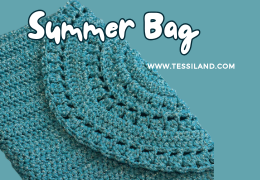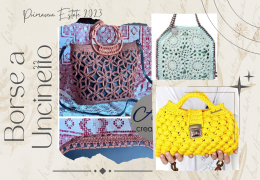Two bags, two styles, one single trend. The Japanese knot takes over summer 2025 with two irresistible crochet...
0 prodotti 0
Your cart is empty
Search in blog
Blog categories
Latest posts
-
 Two crochet bags: the Japanese knot tutorial that speaks the language of the Hadid sisters – summer 2025 editionRead more
Two crochet bags: the Japanese knot tutorial that speaks the language of the Hadid sisters – summer 2025 editionRead more -
 Crochet under the sun: summer 2025 fashion to show off with your best friend (handmade hats included!)27/07/2025Read more
Crochet under the sun: summer 2025 fashion to show off with your best friend (handmade hats included!)27/07/2025Read moreTwo crochet hats perfect for summer: a bucket hat and a mesh hat — fresh, trendy, and easy to make with our free...
-
 The coolest clutch of summer 2025 — and you can make it in 2 must-have colors. Chiedi a ChatGPT23/07/2025Read more
The coolest clutch of summer 2025 — and you can make it in 2 must-have colors. Chiedi a ChatGPT23/07/2025Read moreTwo irresistible colors, one project: the most wanted crochet clutch of summer 2025 is easy to make with the...
-
 Athens the crochet bucket bag to show off at the beach20/07/2025Read more
Athens the crochet bucket bag to show off at the beach20/07/2025Read moreLast project of our Summer Crochet series! Athens is the crochet bucket bag inspired by the colors and elegance of...
-
 Paros the trivet fish a seaside-style decoration for your beach house and beyond17/07/2025Read more
Paros the trivet fish a seaside-style decoration for your beach house and beyond17/07/2025Read moreWant to bring a touch of summer and seaside style into your kitchen? With our crochet tutorial, you can make Paros –...
Popular posts
-
 Crochet bags, the models for spring-summer.29/04/2023One of the most searched accessories on the web, patterns, tutorials, ideas, projects, accessories, here's how to...Read more
Crochet bags, the models for spring-summer.29/04/2023One of the most searched accessories on the web, patterns, tutorials, ideas, projects, accessories, here's how to...Read more -
 Crochet bags for spring summer 2024. 5 models of handmade sling bags.05/04/2024Discover the latest trends for Spring/Summer 2024 with our exclusive guide to 5 crochet sling bag models. Perfect for...Read more
Crochet bags for spring summer 2024. 5 models of handmade sling bags.05/04/2024Discover the latest trends for Spring/Summer 2024 with our exclusive guide to 5 crochet sling bag models. Perfect for...Read more -
 The Crochet Net Bucket Bag: A Trendy Accessory for 202401/06/2024Learn how to make a crochet net bucket bag with our simple and detailed tutorial. Use elastic cord, a size 5 crochet...Read more
The Crochet Net Bucket Bag: A Trendy Accessory for 202401/06/2024Learn how to make a crochet net bucket bag with our simple and detailed tutorial. Use elastic cord, a size 5 crochet...Read more -
 Crochet rugs, a passion that is becoming a trend.21/01/2024In this article, dive into the art of crochet rugs and discover how to create unique and personalized pieces for your...Read more
Crochet rugs, a passion that is becoming a trend.21/01/2024In this article, dive into the art of crochet rugs and discover how to create unique and personalized pieces for your...Read more -
 From runways to street style: the trendiest crochet bags.06/09/2023Are you also passionate about handmade items and want to create your own capsule collection of crochet bags? Here are...Read more
From runways to street style: the trendiest crochet bags.06/09/2023Are you also passionate about handmade items and want to create your own capsule collection of crochet bags? Here are...Read more
You never forget your first crochet piece (but which one to choose?)
Let’s be honest: if you’re thinking about diving into the fabulous world of fashion crochet, the temptation is always the same: “I’m making myself an oversized coat like the one I saw on Pinterest, maybe in orchid purple, which looks great with combat boots and matte lipstick.” No. Stop. Breathe. Put down the 12 mm hook. And listen to someone who’s been there. To start, you need a smart project. One that makes you feel wow, without shouting help.
The trick is: start in style, but keep it simple.
It’s not about settling, but about getting to know yourself through double crochets and chains. Crochet, like every new love story, needs chemistry, trials, adjustments. And a summer tank top is way more manageable than a red carpet dress. Here are 4 perfect projects to start creating your handmade wardrobe (with style, of course).
4 Projects to Start Your Handmade Wardrobe
Simple Tanks
You know those knitted crop tops trending on TikTok? The minimal, clean-cut ones that go with everything? Perfect. A panel tank lets you practice basic stitches and seaming, but without going crazy with shaping, necklines, sleeves, or weird forms.
Bonus: they work up fast and you can wear one with just jeans and a raffia hat.
How to Design a Simple Crochet Tank for Multiple Sizes (42–52)
We’ll work with rectangular panels (same front and back). No shaping. Just:
- correct width → based on starting chain count
- desired height → depending on the style: crop, regular, or long
Step 1: Take Measurements
To calculate the right base, you need two key measurements:
|Chest circumference| measure under the arms, around the fullest part of the bust | determines the tank’s width|
|Desired length| measure from shoulder to waist or hip | determines the panels’ height|
Example:
If you wear size 46 and have a bust circumference of 96 cm, you’ll need to create two panels, each 48 cm wide (48 + 48 = 96).
Step 2: Size Chart Reference
.png)
Step 3: Initial Chain Calculation
To calculate how many chains to start with, you must make a 10x10 cm swatch with your chosen yarn and hook.
Example:
You made a swatch with 4 mm hook and single crochet, getting: 18 stitches in 10 cm
So: 1 cm = 1.8 stitches
Now, if for size 46 you want a 48 cm wide panel:
48 x 1.8 = 86 starting chains
GENERAL FORMULA:
Starting chains = Desired panel width x stitches per cm
TIP: always add 2 extra chains for borders (or 3 if using double crochet).
Step 4: Panel Work
- Once you’ve calculated the width in chains:
- Work in single, double, or a fancy stitch of your choice.
- Continue until you reach the desired length (e.g. 50 cm).
- Make two identical panels (front and back).
- Want thin straps? Set them aside and make separately (e.g. 5–7 stitches per strap, adjustable length).
Step 5: Seams & Finishing
- Sew the sides, leaving an opening for the armholes.
- Sew the straps.
- Finish edges and neckline with a round of single or reverse single crochet.
Want a more summery version?
Choose a yarn like Frida (cotton blend) or ViscoIggy (cool and light) and use openwork stitches like mesh, shell, or granny stitch.
“Crochet Cosmo Cheat Sheet” Recap:
- Make a swatch: count how many stitches fit in 10 cm
- Calculate half of your bust circumference
- Multiply by stitches/cm: you get your starting chains
- Work two rectangles: then sew them together.
Summer Panel Tops
Colorful, breezy, Coachella vibes—even if you’re just on your balcony in Monza. Panel tops are easy to build: two rectangles sewn together, a few side finishes… and voilà, ready for aperitivo.
Pick a cotton yarn like Drake or Donnypattern and play with stripes or simple openwork to train without stress.
Summer Panel Top: Full Guide for Sizes 42–52
We’ll use a classic method:
- Two rectangular panels (front and back)
- Join with side and shoulder seams
- Finish edges with single crochet or drawstrings
- Optional: thin straps, bows, adjustable ties
Step 1 – Take Measurements
You’ll need two measurements:
- Bust circumference = around the fullest part of the chest
- Top length = from shoulder (or under clavicle) to where you want it to end (waist, belly button, hip)
We’ll use panel width = half the bust (since we’re working two panels).
Step 2 – Reference Size Chart
.png)
Step 3 – Starting Chain Calculation
Make a 10x10 cm swatch with your chosen yarn and recommended hook.
Example:
Stitch used: double crochet
Swatch: 10 cm = 16 stitches
So: 1 cm = 1.6 stitches
Now calculate chains for each size:
(Formula: Panel width x stitches per cm)
.png)
Always add: +2 chains for edges
If using open stitches (e.g. mesh, shell), consider the multiple (e.g. 3, 4, or 6) → round to the nearest multiple.
Step 4 – Top Construction
- Start with chains based on your size.
- Work in rows (not in the round) until you reach the desired height.
- Make two identical panels.
Join the panels:
- Sides: leave 18–22 cm open for sleeves (adjustable)
- Shoulders: sew 5–8 cm on each side (leave the center open for deeper neckline if desired)
- Finish edges and neckline with single crochet round
Cool Options:
- Add straps made of chains + single crochet
- Insert a waist drawstring for a gathered effect
- Play with color: stripes, gradients, yarns like Alicia, Diana, Jovy.
- alicia jovy diana
Vests with No Shaping
The vest is the chic version of “I’m practicing but no one needs to know.” Just make three panels: one for the back, two for the front. No sleeves, no shaping, no panic.
Perfect with a white shirt or a light dress. You’ll already feel like a crochet queen.
VEST WITHOUT SHAPING – Guide for Sizes 42/44/46/48/50/52
STRUCTURE
The basic vest is made of 3 rectangular panels:
• 1 back panel
• 2 front panels (one right and one left)
• No shaping, just side and shoulder seams.
REFERENCE MEASUREMENTS (in cm)
.png)
CHAIN CALCULATION: how to do it?
Key steps:
- Make a 10×10 cm swatch with the chosen yarn and hook
- Count how many stitches you have in 10 cm
- Calculate how many chains are needed to reach the panel width
PRACTICAL EXAMPLE
You made a swatch with double crochet using a 4.5 mm hook and medium-weight yarn like Donny, resulting in:
10 cm = 16 stitches
1 cm = 1.6 stitches
FORMULA:
Chains = Panel width (cm) × stitches per cm
CHAINS PER PANEL (with 1.6 st/cm)
BACK PANEL:
.png)
FRONT PANELS (each):
.png)
Always add +2 chains for borders (or +3 if working in double crochet)
VEST CONSTRUCTION – STEP BY STEP
- Create the back panel → work until desired length
- Create the two front panels; leave straight or create a deeper neckline (explained below)
- Join panels with single crochet seam or wool needle:
- Shoulders: 7–10 cm each side
- Sides: leave 18–22 cm open from top for armholes
STYLE VARIATIONS
You can create a V-neck by starting front panels at same height as back, then decreasing 1 stitch every 2 rows on inner side
• Finish edge with crab stitch or picot
• Add a button or central bow
• Use light yarns like Frida, Nirvana, Donnypattern for summer looks, or Chuck for chunkier vests
QUICK SUMMARY FOR SIZE 46 (double crochet example)
• Back panel: 48 cm × 1.6 = 77 chains + 3
• Front panels (×2): 24 cm × 1.6 = 39 chains + 3
• Total length: 54 cm
OVERSIZED SWEATER WITH RECTANGLES
The “Netflix and crochet” project. Two large rectangles sewn together with side slits and soft neckline: a comfy-chic sweater to wear while playfully saying, "I made this, yes. It took me a weekend. Just to relax."
Pro tip (a lifesaver):
Before you begin, choose a clear, well-explained pattern, ideally with step-by-step photos or video. Don’t be tempted by vague tutorials like “chain 45 and follow your intuition.” Intuition is great, but only after your third project.
The side effect?
When you finish your first garment, something strange happens: you start looking at your clothes with a critical eye. “This sweater… I could make it again, better.” Then you realize: it’s not just crochet. It’s empowerment. It’s fashion. It’s art with your hands. And spoiler: it changes everything.
OVERSIZED RECTANGLE SWEATER – Full guide
STRUCTURE
The sweater consists of:
• 2 identical rectangles (front and back)
• Sewn side seams (with armhole openings)
• Shoulder seams (leaving the neckline open)
• Optional: edge finishing on sleeves, hem, and neckline
SIZE MEASUREMENTS – relaxed fit
An oversized fit requires adding 10–15 cm per side beyond bust circumference.
.png)
HOW TO CALCULATE CHAINS
- Make a 10×10 cm swatch with your stitch and yarn
- Count stitches in 10 cm → e.g., 10 cm = 16 stitches → 1 cm = 1.6 stitches
- Multiply panel width by stitches/cm
- Add 2 or 3 chains for border and turning chains
EXAMPLE (with double crochet, 1.6 st/cm):
.png)
If using open or repeat-pattern stitches (e.g., granny, zigzag) ➜ round to the correct multiple.
CONSTRUCTION – STEP BY STEP
- Work two identical rectangles. Panel width as above. Length: 55–65 cm, depending on size and style
- Side seams Leave armhole opening: 18–22 cm from top
- Shoulder seams Sew 8–10 cm each side, leaving neckline center open
- Finishing touches (optional) Sleeve edges in single crochet or crab stitch
- Bottom edge in rib or elastic stitch
- Neckline in V or boat? You decide by adjusting center spacing
STYLE & VARIATIONS
Ideal stitches: double crochet, rectangular granny, mesh, grid stitch
WOW effects: wide stripes, contrast edging, decorative buttons, side slits
SUMMARY FOR SIZE 46
• Bust circumference: 96 cm → oversized at 116 cm
• Panel width: 58 cm
• Stitches/cm: 1.6 (from swatch)
• Starting chains: 58 × 1.6 = 93 + 3 = 96 chains
• Length: around 58 cm
10 Lifesaving Tips.
.png)
1. Always start with a swatch.
Always. Yes, even if you're in a rush. Even if “it’s oversized anyway.” A 10×10 cm swatch helps avoid:
- stitches too loose (beach dress effect... unintentionally)
- stitches too tight (cropped Barbie sweater)
Pro tip: block, steam-press, and then measure the swatch. Never before!
2. Choose stitches that are easy to count
Avoid overly “holey” or elaborate stitches, at least for your first attempt. Ideal:
- Double crochet (for smooth, neat finish)
- Striped granny stitch
- Grid stitch (simple mesh, multiple of 3)
- Seed stitch in crochet
They simplify counting rows and seams!
3. A trick to avoid seam mistakes
- Clip the panels together before sewing.
- Then try on in front of a mirror: adjust shoulders, neckline, length before permanent seaming.
4. Take notes like a designer
- Yarn used + quantity
- Hook size
- Stitch pattern
- Number of chains and rows
- Keep it in a project notebook (or a dedicated blog/Instagram post). It helps for future garments, advising others, and… not reinventing the wheel every time.
5. Oversized ≠ sloppy
Add smart details:
- Contrast edging
- Side slits
- Applied sleeves or simple cuffs
- A statement button on the shoulder
It makes your piece stand out, like it’s from a French fashion lab
6. Wash your garment before wearing
Many yarns (even quality ones) soften or stabilize after the first wash.
Always follow washing instructions on the label (or test on a swatch).
7. Color creates the design
Simple sweater? Make it “wow” with:
- Color blocks (e.g., cream top, coral bottom)
- Asymmetrical stripes
- Solid with gradient yarn (e.g., Taylor or Nirvana)
- Lurex edging or silk-effect
8. “Not perfect” is better than “never started”
- Don’t wait until you’re ready to make a perfect sweater. Start, fail, laugh, undo, repeat.
- Each piece is a lesson and every extra stitch is another superpower
9. Shopping bonus
Always keep an extra skein. Don’t trust calculations blindly: stitch count changes, tension evolves, life changes (like wanting to add sleeves last-minute).
That extra ball can save your project.
10. The twist: gift it to yourself
Create your first oversized sweater thinking of yourself as the muse.
Choose your best color, the stitch that relaxes you, and wear it proudly: you made it. And that’s no small thing.
It’s time to get to work and create your own crochet capsule.
Rosaria Tessiland®
.jpg)



